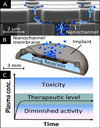The Emerging Role of Nanotechnology in Cell and Organ Transplantation
- PMID: 27257995
- PMCID: PMC4961523
- DOI: 10.1097/TP.0000000000001100
The Emerging Role of Nanotechnology in Cell and Organ Transplantation
Abstract
Transplantation is often the only choice many patients have when suffering from end-stage organ failure. Although the quality of life improves after transplantation, challenges, such as organ shortages, necessary immunosuppression with associated complications, and chronic graft rejection, limit its wide clinical application. Nanotechnology has emerged in the past 2 decades as a field with the potential to satisfy clinical needs in the area of targeted and sustained drug delivery, noninvasive imaging, and tissue engineering. In this article, we provide an overview of popular nanotechnologies and a summary of the current and potential uses of nanotechnology in cell and organ transplantation.
Figures





References
-
- Transplant, N.B.a. Survival Rates Following Transplantation. 2014 Available from: http://www.organdonation.nhs.uk/statistics/.
-
- Recipients, S.R.o.T. 2012 Annual Data Report. 2014 Available from: http://www.srtr.org/.
-
- Gondos A, et al. Kidney graft survival in Europe and the United States: strikingly different long-term outcomes. Transplantation. 2013;95(2):267–274. - PubMed
-
- Collins AJ, et al. US Renal Data System 2013 Annual Data Report. Am J Kidney Dis. 2014;63(1 Suppl):A7. - PubMed
Publication types
MeSH terms
Substances
Grants and funding
LinkOut - more resources
Full Text Sources
Other Literature Sources
Medical
Miscellaneous

